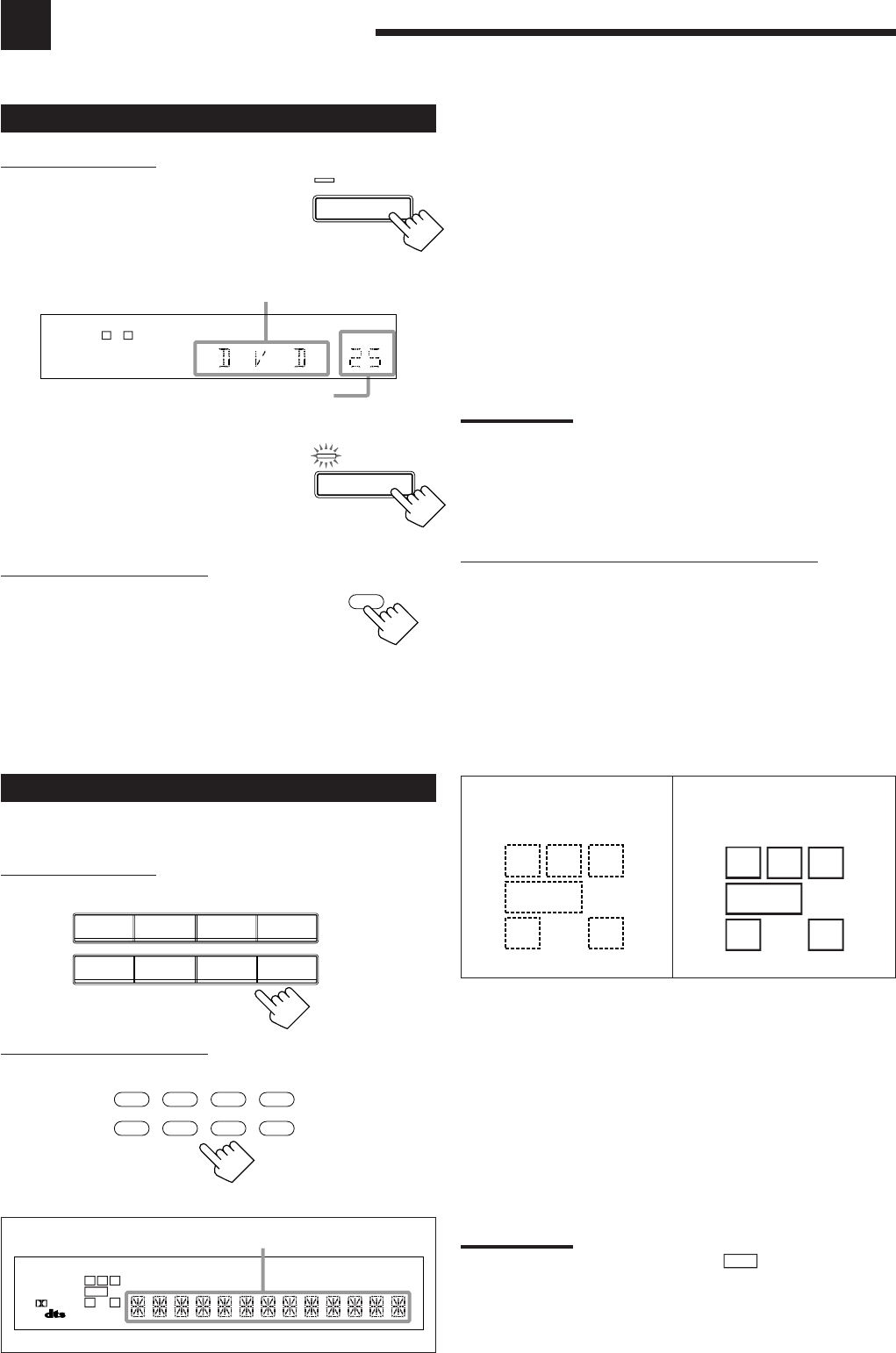
10
Basic Operations
The following operations are commonly used when you play any sound source.
STANDBY
POWER
STANDBY
POWER
AUDIO
POWER
Turning the Power On and Off (Standby)
On the front panel:
To turn on the power, press POWER.
The STANDBY lamp goes off. The name of the
current source (or station frequency) appears on
the display.
To turn off the power (into standby mode),
press POWER again.
The STANDBY lamp lights up. A small amount
of power is consumed in standby mode. To turn
the power off completely, unplug the AC power
cord.
From the remote control:
To turn on the power, press AUDIO
POWER.
The STANDBY lamp goes off. The name of
the current source (or station frequency)
appears on the display.
To turn off the power (into standby mode), press AUDIO POWER
again. The STANDBY lamp lights up.
Selecting the Source to Play
Press one of the source selecting buttons.
On the front panel:
From the remote control:
DVD MUILTIDVD
CD
TAPE/CDRTV/DBS VCR PHONO
FM/AM
DVD VCR
TV SOUND/DBS
CD TAPE/CDR
SOURCE NAME
FM/AM
DVD MULTI
PHONO
SOURCE NAME
L
SPK
VOLUME
ANALOG
1
R
Current volume level is shown here
Current source name appears
Selected source name appears
LC
S.WFR
LS RS
CH-
S
LFE
SPK
PRO LOGIC DSP H.PHONE AUTO MUTING TUNED STEREO
VOLUME
BASS BOOST INPUT ATT SLEEP
DIGITAL AUTO
ANALOG
DIGITAL
LINEAR PCM
12
R
DVD MULTI Select the DVD player for viewing the digital
video disc using the analog discrete output mode
(5.1 CH reproduction).
To enjoy the DVD MULTI playback, see page
27.
DVD Select the DVD player.
VCR Select the video component connected to the
VCR jacks.
TV SOUND/DBS Select TV sounds (or the DBS tuner).
PHONO * Select the turntable.
CD * Select the CD player.
TAPE/CDR * Select the cassette deck (or the CD recorder).
FM/AM * Select an FM or AM broadcast.
• Each time you press the button, the band
alternates between FM and AM.
Notes:
• When connecting a CD recorder (to the TAPE/CDR jacks), and a
DBS tuner (to the TV SOUND/DBS jacks), change the source name
shown on the display. For details, see page 13.
• When you press one of the source selecting buttons on the remote
control marked above with an asterisk (
*
), the receiver
automatically turns on.
Signal and speaker indicators on the display
The signal indicators light up in the following cases:
• Only the indicators for the incoming signals light up.
• When analog input is selected, “L” and “R” always light up.
• When “DVD MULTI” is selected as the source, “L,” “C,” “R,”
“LFE,” “LS” and “RS” light up.
The speaker indicators light up only —:
• When the corresponding speaker is activated.
AND
• When the corresponding speaker is required for the DSP mode
selected currently.
L:•When digital input is selected: Lights up when the left
channel signal comes in.
• When analog input is selected: Always lights up.
R:•When digital input is selected: Lights up when the right
channel signal comes in.
• When analog input is selected: Always lights up.
C: Lights up when the center channel signal comes in.
LS: Lights up when the left rear channel signal comes in.
RS: Lights up when the right rear channel signal comes in.
S: Lights up when the monaural rear channel signal comes in.
LFE:Lights up when the LFE channel signal comes in.
Notes:
• When “SUBWOOFER” is set to “YES,”
S.WFR
lights up.
• When you select “DVD MULTI,” all the signal indicators except “S”
light up.
Signal indicators light up in
red:
Speaker indicators light up
in white:
S.WFR
LS RSS
LFE
RCL
S.WFR
LS RSS
LFE
RCL
EN10_19.RX-7010V[J]_f 00.12.6, 7:23 PM10


















